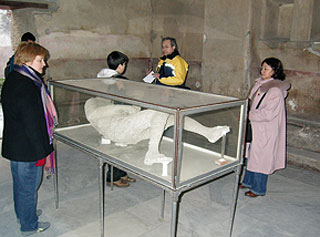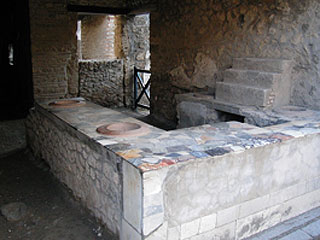
During a trip to the ancient ruins, I discovered that Pompeiians were quite a bit like New Yorkers. Archeologists tell us that many of their houses—which tended to be cramped and small, just like New York apartments—had no kitchen at all, or had only a single small brazier to cook with. What's more, plates were scattered around various rooms, suggesting that the residents enjoyed something like our habit of watching TV while we eat. Pompeii was a Roman city just outside Naples that was destroyed instantly by an eruption of Mt. Vesuvius in 79 A.D. The dormant volcano still looms over the archeological digs. Some say that Pompeii was a pleasure city, not unlike our own Las Vegas, with looser standards of behavior than one might find in Rome itself. Thus there are erotic murals and sculptures scattered around the town, which turned out to be much larger than I'd imagined it, big enough that you could spend an entire day walking the neatly cobbled streets without seeing everything. The archeologist Giussepe Fiorelli, who supervised the digs in the 1860s, developed a method of making ghostly white casts of victims in their death throes, which are gruesomely scattered here and there in the excavation.

As my family and I strutted around the city, admiring bathhouses, stadiums, temples, granaries, and lupanaria (brothels), we kept passing strange narrow buildings, whose fronts were open to the streets. Inside, we saw L-shaped stone counters into which a number of large terra-cotta jars were set. Consulting the free walking guide in English, we discovered to our delight that these were fast-food establishments called thermopolia. Like New Yorkers, Pompeiians were fond of eating on the run, and apparently never ate lunch at home. What did a thermopolium serve? Certainly the sunken jars on one arm of the counter would have contained the mulled spiced wine called calida, but perhaps also stews of meat or lentils. There would have been condiments, too, including honey and garum—the powerfully flavored fish sauce Romans were so fond of. The other leg of the counter probably displayed bread, cheese, dates, olives, and other snacks, while the stepped shelves behind the counter—reminiscent of booze displays in our own cocktail lounges—probably featured eating and drinking utensils. Two hundred thermopolia have been identified in the ruins of Pompeii, many clustered around bathhouses. What could be better than a snack after a trip to the baths or the brothels?

